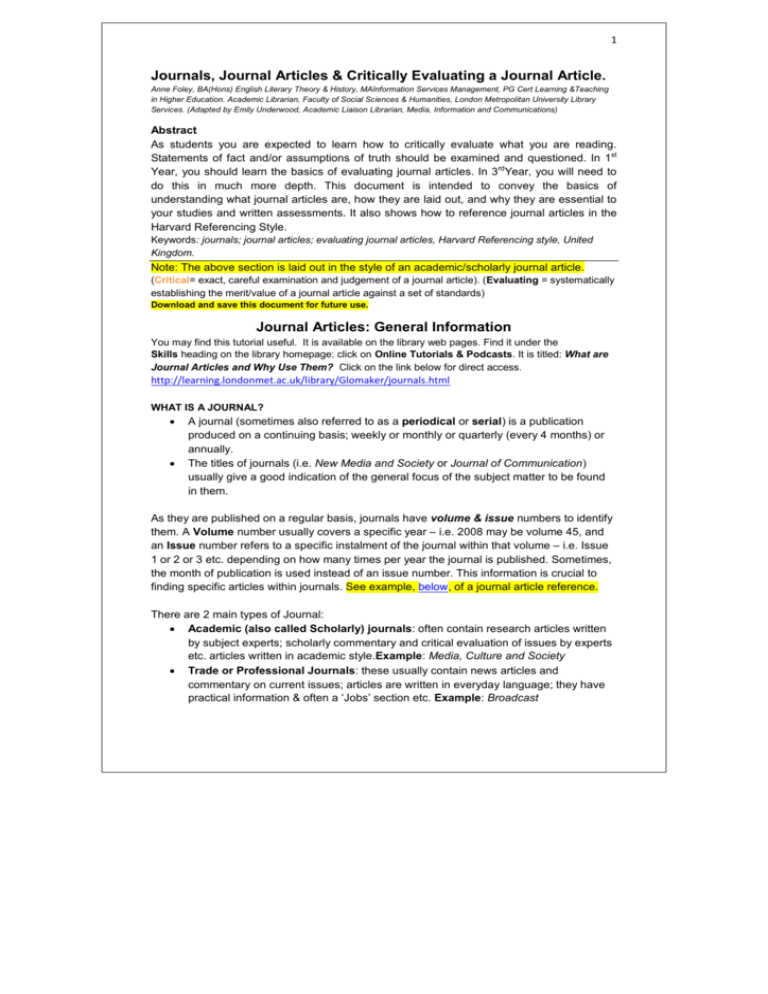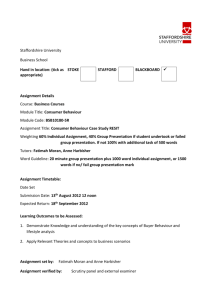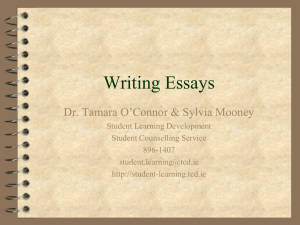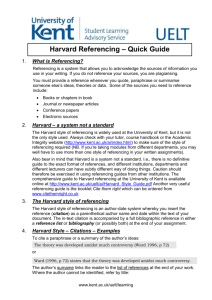Journals, Journal Articles & Critically Evaluating a Journal Article
advertisement

1 Journals, Journal Articles & Critically Evaluating a Journal Article. Anne Foley, BA(Hons) English Literary Theory & History, MAInformation Services Management, PG Cert Learning &Teaching in Higher Education. Academic Librarian, Faculty of Social Sciences & Humanities, London Metropolitan University Library Services. (Adapted by Emily Underwood, Academic Liaison Librarian, Media, Information and Communications) Abstract As students you are expected to learn how to critically evaluate what you are reading. Statements of fact and/or assumptions of truth should be examined and questioned. In 1st Year, you should learn the basics of evaluating journal articles. In 3rdYear, you will need to do this in much more depth. This document is intended to convey the basics of understanding what journal articles are, how they are laid out, and why they are essential to your studies and written assessments. It also shows how to reference journal articles in the Harvard Referencing Style. Keywords: journals; journal articles; evaluating journal articles, Harvard Referencing style, United Kingdom. Note: The above section is laid out in the style of an academic/scholarly journal article. (Critical= exact, careful examination and judgement of a journal article). (Evaluating = systematically establishing the merit/value of a journal article against a set of standards) Download and save this document for future use. Journal Articles: General Information You may find this tutorial useful. It is available on the library web pages. Find it under the Skills heading on the library homepage: click on Online Tutorials & Podcasts. It is titled: What are Journal Articles and Why Use Them? Click on the link below for direct access. http://learning.londonmet.ac.uk/library/Glomaker/journals.html WHAT IS A JOURNAL? A journal (sometimes also referred to as a periodical or serial) is a publication produced on a continuing basis; weekly or monthly or quarterly (every 4 months) or annually. The titles of journals (i.e. New Media and Society or Journal of Communication) usually give a good indication of the general focus of the subject matter to be found in them. As they are published on a regular basis, journals have volume & issue numbers to identify them. A Volume number usually covers a specific year – i.e. 2008 may be volume 45, and an Issue number refers to a specific instalment of the journal within that volume – i.e. Issue 1 or 2 or 3 etc. depending on how many times per year the journal is published. Sometimes, the month of publication is used instead of an issue number. This information is crucial to finding specific articles within journals. See example, below, of a journal article reference. There are 2 main types of Journal: Academic (also called Scholarly) journals: often contain research articles written by subject experts; scholarly commentary and critical evaluation of issues by experts etc. articles written in academic style.Example: Media, Culture and Society Trade or Professional Journals: these usually contain news articles and commentary on current issues; articles are written in everyday language; they have practical information & often a ‘Jobs’ section etc. Example: Broadcast 2 WHAT IS A JOURNAL ARTICLE? Journals contain several articles, written by subject experts or researchers or practitioners within the subject area. Some journals contain articles covering a diverse set of topics related to the subject area. The title Media, Culture and Society, for example, indicates that this journal contains articles relating to all aspects of media and culture. Not all journals, as you can see from the example above, have the word JOURNAL in their titles. HOW TO RECOGNISE A JOURNAL ARTICLE ON A READING LIST, BIBLIOGRAPHY ETC. Title of Article Volume & Issue Numbers Bethany, K. (2011) Entertaining ideas: social issues in entertainment television. Media, Culture and Society, 33(6), 905-921. Page numbers of article Author Year of Publication Title of Journal (in Italics) THERE ARE 2 MAIN TYPES OF JOURNAL ARTICLE: Empirical (also called primary) research: the author/s have carried out first-hand research, and are presenting, describing, evaluating and drawing conclusions from their research. Secondary research (also called desk research): author/s summarise, synthesize and draw conclusions on the published works of other authors. THE USUAL LAYOUT& CONTENT OF AN ACADEMIC/SCHOLARLY JOURNAL ARTICLE This is an indication of how a journal article is usually laid out; not all are laid out in this exact way . Title: indicating/describing the subject of the article. Author/s: Name/s and, often, their credentials/qualifications and place of work/affiliation. Abstract: a summary of the article describing the article’s purpose, method, results and conclusions. Keywords: words used to describe the main topics within the article. These are used for various reasons, i.e. when scanning for relevance of the article to your own studies, to help retrieve the article from an online database. Introduction: sets the scene; describes what the article is about, what the issue is being addressed in the article etc. Section heading: detailed statement of the issue being addressed. The title of the heading should indicate the specific sub-topic being described in that section. Literature Review: this section details other literature related to the issue being addressed and how it informs the current work. Not found in every article, mainly in research articles. Methodology/method: if the article is describing research, this explains the method used to collect data. Other Section headings & section content: variously describe,in depth, either the literature review, analysis of research carried out (if a research article), or giving an indication of the contents of the section. Findings: if the article is describing research, the Findings detail the results of the research. Conclusion/discussion/ recommendations: this sections summarises the conclusions drawn from the research (if a research article), discusses the implications of the research findings. London Metropolitan University Library Services Anne Foley Librarian for Social Work October 2011 3 References: an alphabetical list, by author, of the sources (books, journal articles, reports, statistics etc.) referred to (cited) in the article. WHY READ JOURNAL ARTICLES? They contain up-to-date information and debate on current topics in your subject area They contain specialised information that may not be available elsewhere They describe research by experts in your subject area. Most academic journal articles are peer-reviewed before publication. This means that the articles have a guarantee of quality. Critically Evaluating a Journal Article (Critical= exact, careful examination and judgement) (Evaluating = systematically establishing the merit/value of a journal article against a set of standards) This is a guide to a basic critical evaluation of a journal article. It should be sufficient for your current purposes, i.e. finding articles which provide evidence to support statements/claims/arguments you will make in your presentations in Week 10. As you progress in your studies, you will be required to critically evaluate journal articles in more depth. Your essay for this module should contain references to journal articles you have used and these articles MUST be relevant to, and provide evidence of, claims/statements/ arguments you present in your essay. All articles used in your essay must be referenced. IS THE ARTICLE RELEVANT TO THE TOPIC YOU ARE RESEARCHING AND IS IT RELIABLE? To answer this question, examine the article, asking the following questions: Is the article related to the UK (Geographical Context)? Alternatively, if you are, for example, doing a comparison between the UK and another country you will need articles relating to that country. The abstract, keywords or references made in the main content of the article will indicate the geographical context. What is the main issue being discussed? Is this issue significant/relevant to the topic you are researching? The abstract and/or keywords will usually provide enough evidence to help you decide. Does the author provide their credentials (Authority)? Do these credentials indicate that this author has the expertise or experience to write on this topic? This can be established either alongside the author’s name, under the title of the article, or in the main content of the article. What are the major concepts discussed in the article? You may need, for instance, to establish the theoretical standpoint the author is writing from, i.e. critical theory, feminist theory, Marxist theory, social constructivist theory – or a combination of theoretical standpoints. Often, the author will state her/his theoretical standpoint but, more often, this is implicit in the text. This can be quite difficult to establish as a new student but, as your studies progress and your knowledge broadens, this will become easier. What are the important facts presented in the article? To quickly establish this, look at the conclusion, as this is where the facts and findings are summarised. Can you verify the facts presentedby the author in the article? A scholarly/academic article will have citations within the text (called in-text citations), used to provide evidence of claims made, and a reference list which provides full London Metropolitan University Library Services Anne Foley Librarian for Social Work October 2011 4 details of the source of these citations. The reference list is provided in order for readers to verify claims made by the author. What conclusion does the author reach about the main issue? Do these conclusions match your own (or other authors’ works you have read) views on the issue? If not, are the arguments good enough to make you reconsider your own views? If not, can you find evidence from other articles or sources to support your views – do they make a more persuasive argument and, if so, why? What are the arguments presented as evidence of, or to support, the conclusions drawn at the end of the article? Do the facts presented by the author support the arguments? A good scholarly article will present the evidence in a clear, systematic manner; laying out each issue and describing exactly how the evidence proves the claim they are making in the conclusion. Sometimes, the author’s conclusion is that the research has not provided clear evidence to support an issue and recommends that further research is necessary. Does the author use emotional words or phrases or is the article written in a neutral manner? A good academic/scholarly article should not use emotional terminology or words in order to influence or manipulate the reader into accepting their views. An argument, written in a neutral, emotionless manner, presenting evidence for claims made, is a key element of a good academic article. Referencing & Citing Journal Articles in Your Work: Harvard Referencing Style A very good guide to referencing is provided by Imperial College London, on their web pages. The direct link to this is: https://workspace.imperial.ac.uk/library/Public/Harvard_referencing.pdf You can also find it by searching Google, using the words ‘Imperial College Harvard Referencing Guide’. It is advisable to download and save this guide for future use. Alternatively, use the Citing Your References guide on the library web page. WHAT IS A REFERENCE LIST? At the end of each essay, you will need to provide a list of the works you have cited/referred to in your work. This list must be in A-Z order, by author’s name. It must be done in a very exact manner (that’s why there is a guide) and students will usually lose marks for their work if they do not reference in the proper manner. When doing your references for an essay, for example, you will have references to more than just journal articles. You will also have, at least, textbooks. All references should be included in a single list, in alphabetical order by the author of the book or article. The following is an example of a very short, simple reference list of journal articles and books, in Harvard Referencing style. For a breakdown of the elements of a journal article reference, see page 2 of this document. For information on referencing other sources, read the Imperial College Harvard Referencing Guide. Alternatively, under the Skills section on the library web page you will find a linkr look at the Citing Your References guide on the library web page. References Bull, S. (2009) Photography, London: Routledge. (Book reference: single author). London Metropolitan University Library Services Anne Foley Librarian for Social Work October 2011 5 Cobley, P. and Haeffner, N. (2009) Digital cameras and domestic photography: communication, agency and structure. Visual Communication, 8 (2), 123-146. (Journal article reference, two authors). Hill, J & Gibson, P.C. (eds.) (2000) World Cinema: critical approaches. Oxford: OUP. (Book reference, edited book, two editors). Nickel, D. (2005) Snapshots: The Photography of Everyday Life: 1888 to the Present. San Francisco: Museum of Modern Art. (Book reference; single author). FINDING DETAILS FOR YOUR REFERENCES Books: dates, publishers etc. of books; either look within the book, at the back of the title page, or on the library catalogue. Journal Articles: title of journal, volume etc.; this can usually be found on the cover page of a downloaded article or at the bottom of the first page of the article or elsewhere within the article. WHAT IS A BIBLIOGRAPHY? You will sometimes see the words ‘references’ and ‘bibliography’ used as if they mean the same thing. They do not. A reference list is a list of all sources cited in your essays. A bibliography is a full list of all the material consulted in relation to your essay, whether cited within the work or not. You will not usually be asked to produce a bibliography for your essays. Most essays & projects require a reference list only. WHAT IS CITING? When you use ideas from a journal articles, books etc. in your essays, you will need to cite them within the text. Some Examples of Citing, Harvard Style, in the Text of an Essay: Making a general statement about an author/s work: A recent study showed that students who read and reference journal articles in their work tend to gain higher grades than their peers who do not (Tossell, 2011). Describing specific findings or statements from an author’s work: Prior research finds that people tend to replay online games not only because of the perceived fun, but also because of the distorted notion of time and space involved, or social escapism (Nelson, 2005). Using direct quotes from an author’s work: When studying the eating habits of undergraduate social work students in a university, Foley found that ‘they never bring food into the library as they know that it is not allowed’ (2011, p. 18) Use single quotation marks for direct quotes. Double quotation marks usually denote speech rather than written works. For further help with citing in your work, go to the Imperial College Harvard Referencing web pages and click on ‘What is citing?’ This is a direct link to the web page: http://www3.imperial.ac.uk/library/subjectsandsupport/referencemanagement/harvard/citing London Metropolitan University Library Services Anne Foley Librarian for Social Work October 2011




